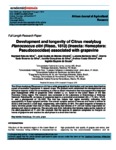Please use this identifier to cite or link to this item:
http://www.alice.cnptia.embrapa.br/alice/handle/doc/1031898Full metadata record
| DC Field | Value | Language |
|---|---|---|
| dc.contributor.author | SILVA, R. R. da | pt_BR |
| dc.contributor.author | OLIVEIRA, J. E. de M. | pt_BR |
| dc.contributor.author | SILVA, L. B. | pt_BR |
| dc.contributor.author | SILVA, C. S. B. da | pt_BR |
| dc.contributor.author | SILVA, J. G. da | pt_BR |
| dc.contributor.author | OLIVEIRA, A. C. | pt_BR |
| dc.contributor.author | SOUZA, I. D. de | pt_BR |
| dc.date.accessioned | 2015-12-17T11:11:11Z | pt_BR |
| dc.date.available | 2015-12-17T11:11:11Z | pt_BR |
| dc.date.created | 2015-12-17 | pt_BR |
| dc.date.issued | 2015 | pt_BR |
| dc.identifier.citation | African Journal of Agricultural Research, v. 10, n. 35, p. 3543-3547, 2015. | pt_BR |
| dc.identifier.uri | http://www.alice.cnptia.embrapa.br/alice/handle/doc/1031898 | pt_BR |
| dc.description | The Citrus mealybug Planococcus citri has a wide geographical distribution and has been describedas a pest of economic importance in several crops. The present work determined the developmental and biological aspects of the Citrus mealybug in order to obtain information that may support the integrated pest management (IPM) of grapevine (Vitis viniferaL.) cv. Syrah in the Lower Basin of the São Francisco Valley region. The research was conducted at the Laboratory of Entomology of Embrapa Semiarid, Petrolina-PE, on leaves of grapevine kept in a controlled environment (25 ± 1°C, 60 ± 10% R. H. and a photoperiod of 12L:12D). The first two instars had higher mortality, indicating high susceptibility in these nymphal periods. The overall nymphal period of females and males is similar at 22.52 ± 0.46 and 23.5 ± 0.29 days, respectively, with viability of 39%. The adult longevity of femalesis nearly 30 times greater than that of males, indicating that females of P. citriare mainly responsible for damage and injury to grapevine. The sex ratio was 0.64, indicating that females make up the majority of the adult population of P. citri. We conclude that the species in question completes its lifecycle on leaves of grapevine and reaches the adult phase in a short time interval. | pt_BR |
| dc.language.iso | eng | eng |
| dc.rights | openAccess | eng |
| dc.subject | Vale do São Francisco | pt_BR |
| dc.subject | Citrus cochonilha | pt_BR |
| dc.subject | Mealybugs | pt_BR |
| dc.subject | Manejo integrado | pt_BR |
| dc.title | Development and longevity of Citrus mealybug Planococcus citri (Risso, 1813) (Insecta: Homoptera: Pseudococcidae) associated with grapevine. | pt_BR |
| dc.type | Artigo de periódico | pt_BR |
| dc.date.updated | 2016-03-29T11:11:11Z | pt_BR |
| dc.subject.thesagro | Uva | pt_BR |
| dc.subject.thesagro | Praga | pt_BR |
| dc.subject.thesagro | Cochonilha | pt_BR |
| dc.subject.thesagro | Ciclo de Vida | pt_BR |
| dc.subject.thesagro | Vitis Vinifera | pt_BR |
| dc.subject.nalthesaurus | Grapes | pt_BR |
| dc.subject.nalthesaurus | Planococcus citri | pt_BR |
| riaa.ainfo.id | 1031898 | pt_BR |
| riaa.ainfo.lastupdate | 2016-03-29 | pt_BR |
| dc.identifier.doi | 10.5897/AJAR2015.9559 | pt_BR |
| dc.contributor.institution | RAPHAEL REIS DA SILVA, Universidade Federal de Lavras; JOSE EUDES DE MORAIS OLIVEIRA, CPATSA; LUCIANA BARBOZA SILVA, UFPI; CHERRE SADE BEZERRA DA SILVA, Universidade Federal do Recôncavo da Bahia; JOCÉLIA GONÇALVES DA SILVA; ANDREA COSTA OLIVEIRA, UPE; INGRIDE DAYANE DE SOUZA, UFRPE. | pt_BR |
| Appears in Collections: | Artigo em periódico indexado (CPATSA)  | |
Files in This Item:
| File | Description | Size | Format | |
|---|---|---|---|---|
| Eudes2015.pdf | 286.59 kB | Adobe PDF |  View/Open |









